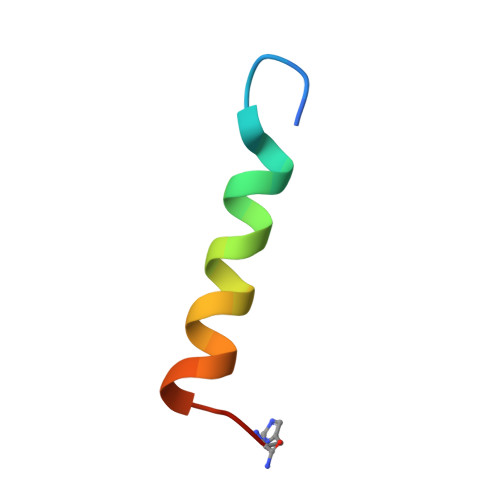A hemocyanin-derived antimicrobial peptide from the penaeid shrimp adopts an alpha-helical structure that specifically permeabilizes fungal membranes.
Petit, V.W., Rolland, J.L., Blond, A., Cazevieille, C., Djediat, C., Peduzzi, J., Goulard, C., Bachere, E., Dupont, J., Destoumieux-Garzon, D., Rebuffat, S.(2015) Biochim Biophys Acta 1860: 557-568
- PubMed: 26708991
- DOI: https://doi.org/10.1016/j.bbagen.2015.12.010
- Primary Citation of Related Structures:
2N1C, 2N30 - PubMed Abstract:
Hemocyanins are respiratory proteins with multiple functions. In diverse crustaceans hemocyanins can release histidine-rich antimicrobial peptides in response to microbial challenge. In penaeid shrimp, strictly antifungal peptides are released from the C-terminus of hemocyanins. The three-dimensional structure of the antifungal peptide PvHCt from Litopenaeus vannamei was determined by NMR. Its mechanism of action against the shrimp pathogen Fusarium oxysporum was investigated using immunochemistry, fluorescence and transmission electron microscopy. PvHCt folded into an amphipathic α-helix in membrane-mimicking media and displayed a random conformation in aqueous environment. In contact with F. oxysporum, PvHCt bound massively to the surface of fungal hyphae without being imported into the cytoplasm. At minimal inhibitory concentrations, PvHCt made the fungal membrane permeable to SYTOX-green and fluorescent dextran beads of 4 kDa. Higher size beads could not enter the cytoplasm. Therefore, PvHCt likely creates local damages to the fungal membrane. While the fungal cell wall appeared preserved, gradual degeneration of the cytoplasm most often resulting in cell lysis was observed in fungal spores and hyphae. In the remaining fungal cells, PvHCt induced a protective response by the formation of daughter hyphae. The massive accumulation of PvHCt at the surface of fungal hyphae and subsequent insertion into the plasma membrane disrupt its integrity as a permeability barrier, leading to disruption of internal homeostasis and fungal death. The histidine-rich antimicrobial peptide PvHCt derived from shrimp hemocyanin is a strictly antifungal peptide, which adopts an amphipathic α-helical structure, and selectively binds to and permeabilizes fungal cells.
- Laboratory Molécules de Communication et Adaptation des Microorganismes (MCAM, UMR 7245), Muséum national d'Histoire naturelle (MNHN), Centre national de la Recherche scientifique (CNRS), Sorbonne Universités, 75005 Paris, France.
Organizational Affiliation:
















